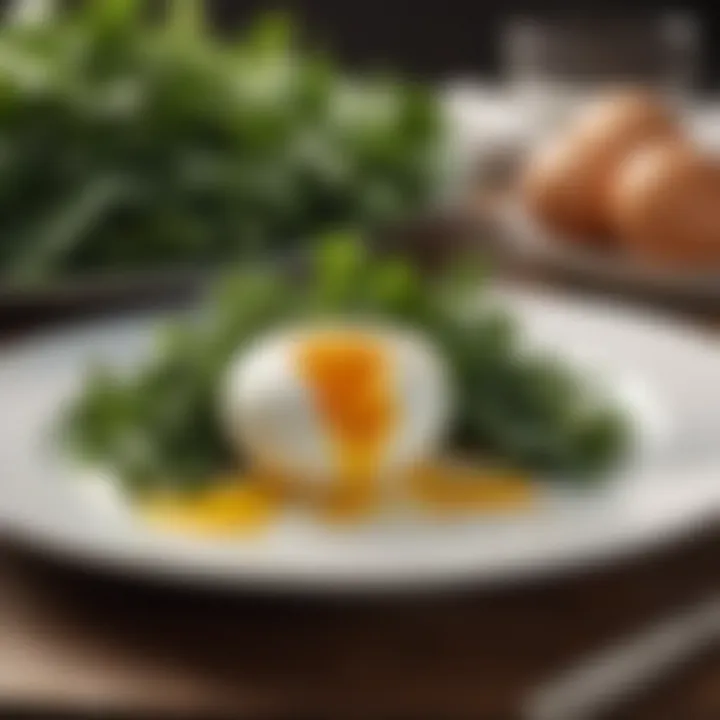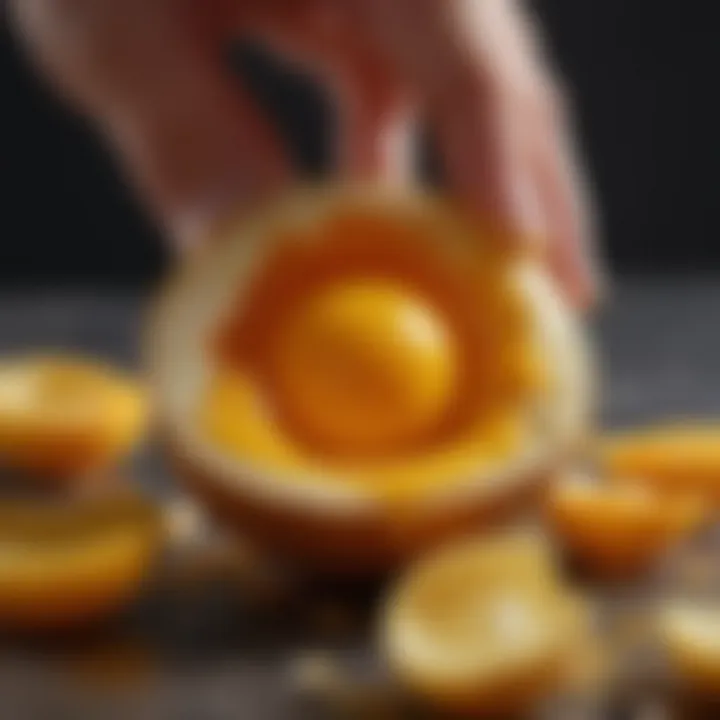Microwaving Eggs: Mastering the Art of Poaching


Intro
Poaching eggs can seem daunting, especially for those without stovetop experience. Uniquely, microwave poaching offers an innovative solution that simplifies this process. It allows cooks of all skill levels to achieve poached eggs reliably and efficiently. This guide explores the various aspects of microwaving eggs, emphasizing techniques that yield perfect results.
Understanding the basics as well as the subtleties of microwaving eggs can transform your approach to breakfast and beyond. Besides simplicity, poaching eggs in a microwave can save time, reducing meal prep during busy mornings.
In this article, we will dissect the art of poaching, covering not only the technical aspects but also the benefits this technique brings to the culinary table. Let's delve into a structured overview of the recipe!
Understanding Microwave Egg Cooking
Microwave egg cooking presents a modern approach to traditional culinary practices. It allows for speed and convenience, which are crucial in today’s fast-paced environment. Understanding microwave egg cooking is vital for anyone looking to perfect the poaching method. This section explores the core elements that make it a beneficial technique.
Microwaving eggs retains their nutrients better than some other cooking methods. This is because they spend less time exposed to high heat. Furthermore, microwaving can be a less messy option compared to boiling on the stovetop. Fewer dishes and less cleanup time can appeal to both novice and seasoned cooks.
Using this method also opens up a range of possibilities. For those who might not have access to a stove or prefer not to use one, microwaving becomes a preferable alternative. The flexibility of this technique makes it suitable for diverse dietary requirements while maintaining a focus on flavor and texture.
Key considerations include understanding your microwave's wattage, as this can affect cooking times. Each microwave may operate differently, which could influence how effectively eggs are poached. It is essential to observe closely and adjust as needed based on specific appliance characteristics.
The Equipment Required
Understanding the equipment needed for microwaving eggs is essential. It helps ensure that the poaching process runs smoothly and results in perfectly cooked eggs. Whether you are a novice cook or someone with experience, having the right tools can make a significant difference in your results. This section elaborates on the essential kitchen tools and the specifics of the microwave itself, shedding light on why they are crucial for poaching eggs effectively.
Essential Kitchen Tools
Having the correct kitchen tools can simplify the process of poaching eggs in a microwave. Here are some vital items:
- Microwave-Safe Bowl: Choosing a bowl that is safe for microwave use is crucial. Glass or ceramic bowls are preferred, as they can withstand high temperatures without breaking.
- Lid or Plate: Covering the bowl is important. A lid or a microwave-safe plate helps to trap steam, promoting even cooking and reducing spilling.
- Measuring Cup or Spoon: Accurate measurement of water is key to achieving the right texture of the poached egg. A measuring cup or spoon can help with this precision.
- Fork or Slotted Spoon: To remove the poached egg from the bowl, a fork or slotted spoon is handy. It allows for gentle lifting without breaking the yolk.
Microwave Specifics
Microwaves differ based on make and model, affecting how they cook food. Here are a few considerations to keep in mind regarding your microwave:
- Wattage: Most microwaves range from 600 to 1,200 watts. The wattage will influence the cooking time. Higher wattage means faster cooking, which can lead to more precise timing.
- Turntable or Carousel: If your microwave has a turntable, it ensures even cooking by rotating food during the heating process. Knowing whether your model has this feature can help in managing cooking times.
- Cook Settings: Many microwaves come with specific settings for cooking eggs or defrosting. Familiarize yourself with these options to optimize your cooking experience.
"Understanding your equipment is as essential as mastering the techniques of cooking. It lays the foundation for achieving desired results."
With an awareness of the equipment needed, you can proceed confidently to poaching eggs in your microwave. The tools outlined above will help streamline the process and enhance your results.
Preparing to Poach an Egg
Preparing to poach an egg is a critical step in ensuring a successful outcome in the microwave. Understanding what goes into this process not only influences the taste and texture of the final dish, but also affects the ease of preparation. With the right knowledge in this phase, any cook can avoid common issues and enhance the poaching experience.
Choosing the Right Eggs
The first step is selecting high-quality eggs. Fresh eggs are essential for achieving that perfect poached texture. Freshness can be determined by checking the pack date or using the water float test; if an egg sinks, it is fresh. A fresh egg has a tighter albumen, which helps it hold its shape better when poaching.
Furthermore, consider using free-range or organic options. These eggs often have a richer flavor due to the hens' varied diets. While not mandatory, the choice of eggs can influence the overall experience and provide subtle variations in taste.
Optimal Liquid Choices
Liquid choice is another corner stone in the poaching process. Water is the traditional choice, but various alternatives can enrich the flavor profile. Here are some considerations:
- Water: Plain water is the most common medium. Using room-temperature water is best, but cold water can work if timed correctly.
- Vinegar: A small amount of vinegar can help as well; it aids in coagulating the egg whites more quickly, which can lead to a neater appearance.
- Broth: For those seeking flavor, vegetable or chicken broth can be an excellent substitute for water; it adds a depth that plain water cannot.
- Stock: Similar to broth, using stock provides a richer taste, which complements many dishes.
The right choice of liquid can enhance not only the taste but also the visual appeal of the poached eggs. Consider experimenting to find the optimal balance that suits your palate.
By paying attention to these details during preparation, cooks can increase their chances of creating perfectly poached eggs in the microwave, paving the way for a delightful culinary experience.
Step-by-Step Guide to Microwave Poached Eggs
The process of poaching eggs in the microwave is both an art and a science, combining technique with precise control. This section is crucial in guiding readers through the method, highlighting not just the steps involved but also the benefits and considerations. Poaching eggs can appear intimidating to some, but this method simplifies the cooking process, making it accessible to cooks of various skill levels.
Overview of the Poaching Process
Poaching eggs involves cooking them gently in simmering water. Using a microwave requires an understanding of how microwave energy interacts with eggs. The microwave's energy heats water quickly, resulting in a unique poaching environment compared to traditional methods.
To start, a microwave-safe bowl is crucial, preferably one that can hold water deep enough to submerge the egg fully. Ensuring the egg is consistently submerged helps achieve the delicate poaching effect that is sought after. The timing is another vital factor, as eggs can cook unevenly in the microwave due to varying power levels.
Detailed Poaching Instructions


Careful execution of steps ensures optimal results when poaching eggs in the microwave. Follow these detailed instructions for successful poaching.
Timing Parameters
Timing is perhaps the most critical aspect of microwaving poached eggs. Different microwave ovens vary in wattage, thus the actual cooking time may differ. Generally, 45 seconds to 1 minute is a good starting point. After initial cooking, check the egg’s doneness. If necessary, additional 10-second intervals may be added.
- Key characteristic: Precision in timing helps prevent overcooking.
- Benefits: Correct timing will help maintain the egg's soft texture, which is often lost if overcooked.
- Unique feature: The timing can be adjusted based on egg size; larger eggs may require more time.
- Drawback: Microwaves can produce varied results, making earlier checks critical.
Water Temperature
Water temperature plays a significant role in poaching eggs effectively. Using hot, almost boiling water creates an ideal environment. The heat ensures the egg whites set while the yolk remains runny. Incorrect temperature can lead to either a rubbery texture or an undercooked egg.
- Key characteristic: Maintaining the water temperature close to boiling allows for faster cooking.
- Benefits: An optimal temperature contributes to desired textures in the egg.
- Unique feature: Adding a dash of vinegar can help firm the egg whites, making them less likely to disperse.
- Drawback: A temperature that's too low may not cook the egg whites adequately, leading to a less appealing result.
Egg Placement
The placement of the egg in the bowl is vital for even cooking. Carefully crack the egg into the center of the water. This positioning allows the egg to cook uniformly, reducing the chances of one side cooking faster than the other.
- Key characteristic: Centering the egg helps in achieving an even poach.
- Benefits: Proper placement avoids issues like uneven cooking or splattering.
- Unique feature: Utilizing a mug can make placement easier, providing a more controlled environment.
- Drawback: Ignoring placement can result in a messy microwave and inconsistent texture.
"Understanding the step-by-step process enhances the overall poaching experience and results in superior eggs."
Proficiency in these steps ensures that the final product is not only appealing but also meets the expectations of a perfectly poached egg. Each element, from timing to water temperature and egg placement, contributes fundamentally towards this culinary technique.
Common Pitfalls and Solutions
Microwaving eggs to poach them is a quick and effective cooking technique. However, it is not without challenges. Understanding common pitfalls can save time and prevent frustration. Being aware of these issues allows cooks to refine their method and achieve a perfectly poached egg consistently.
Overcooking Issues
One of the most frequent problems faced when poaching eggs in the microwave is overcooking. When eggs are microwaved for too long, they can become rubbery and lose their appealing texture. The key to avoiding this lies in precise timing.
Microwaves vary in wattage, which impacts cooking time. It is advisable to start with a lower time setting and gradually increase it if necessary. Generally, a time range of 30 to 60 seconds is a good start, depending on the microwave's power. Always check for doneness; the egg white should be set, while the yolk remains soft.
Here are some tips to prevent overcooking:
- Short intervals: Cook in 15-second intervals after the initial time.
- Cover the dish: Using a microwave-safe cover can help retain moisture and heat evenly.
- Monitor closely: Stay near the microwave to keep an eye on the egg as it cooks.
Undercooked Results
Conversely, undercooked eggs pose another common issue. Undercooked poached eggs can leave the white runny and the yolk too raw for some preferences. This can occur if the cooking time is insufficient or if the egg is not placed properly in the water.
To ensure proper cooking, follow these guidelines:
- Water temperature: Make sure the water is hot but not boiling before adding the egg.
- Egg placement: Gently crack the egg into the water, ensuring it is fully submerged. This helps it cook evenly.
- Test for doneness: Similar to overcooking, testing after the recommended time is essential. The white should be set, and the yolk should feel slightly firm.
Messy Microwave Cleanup
Cleaning the microwave after poaching eggs can be an unpleasant task. Eggs can splatter, causing residue that can be tough to wipe away. To minimize this, prevention is key.
Here are some strategies for keeping your microwave clean:
- Use a microwave-safe cover: This helps to contain any splatter during cooking.
- Choose the right container: Opt for deep, microwave-safe dishes that can hold the egg and water without spilling.
- Immediate cleaning: Wipe the inside of the microwave with a damp cloth soon after use. This prevents buildup and makes it easier to maintain the appliance.
Understanding these common pitfalls is essential for mastering the art of microwaving poached eggs. With attention to detail and practice, successful results can be achieved with ease.
Variations on the Classic Poached Egg
Exploring variations on the classic poached egg opens a realm of culinary possibilities. While the traditional poached egg is a delightful dish by itself, adding personal twists can enhance its flavor and texture. Not only does this enrich the eating experience, but it also caters to diverse palates and dietary preferences. Incorporating different ingredients and serving suggestions allows for creativity in the kitchen, making poached eggs a versatile meal option.
Adding Ingredients
When it comes to poaching eggs in the microwave, adding ingredients can elevate the dish. This section focuses on flavorful enhancements that can transform your eggs.
Spices
Spices bring complexity and vibrancy to poached eggs. A dash of cayenne or smoked paprika can introduce heat and depth. The key characteristic of spices is their ability to impart distinct flavors without needing additional cooking time, making them an excellent choice for microwave cooking.
One unique feature of spices is their variety; from savory to sweet, they can complement the natural taste of eggs. However, care should be taken when choosing spices, as some can overpower the delicate flavor of the eggs. Thus, moderation is necessary to maintain balance in the dish.
Herbs


Incorporating herbs into microwave-poached eggs provides a fresh and aromatic element. Basil, chives, and parsley are popular herbs that pair well with eggs. Their key characteristic is the way they enhance the dish’s freshness while also adding color.
Herbs also offer nutritional benefits, with many containing antioxidants and vitamins. The challenge is ensuring that these delicate ingredients are added after cooking to preserve their flavor and properties, as high heat can diminish their impact.
Cheese
Adding cheese can transform poached eggs into a creamy delight. Cheeses such as feta, goat cheese, or cheddar can be mixed in or sprinkled on top. The key characteristic of cheese is its rich texture and ability to add a comforting element to the meal.
One unique feature of cheese is the variety of flavors it offers, from sharp to mild, allowing for customization. However, fat content in cheese should be considered, especially for those monitoring calorie intake. It is important to balance indulgence with health-conscious choices.
Serving Suggestions
How poached eggs are served can significantly affect the dining experience. This section discusses various options for enjoying poached eggs, enhancing their appeal.
Toast
Serving poached eggs on toast is a classic choice. The crunch of the bread contrasts beautifully with the tenderness of the egg. This combination provides textural variety and enhances flavor through the interaction between the egg and the bread.
The unique feature of toast lies in its ability to absorb the egg’s runny yolk, creating a satisfying bite. However, the type of bread used can alter the experience; whole-grain varieties can add nutritional value but may also compete with the egg's flavor.
Salads
Adding poached eggs to salads elevates the dish to new heights. The creamy yolk can act as a dressing, enriching the salad without the need for additional fats. Greens like spinach, arugula, or mixed greens pair well with the soft egg, creating a balanced meal.
Salads with poached eggs are not only visually appealing but also nutritious, incorporating a range of vegetables. However, it’s important to ensure that with additions like vinaigrettes, flavors do not clash.
Pasta
Poached eggs can also serve as a protein-rich topping for pasta dishes. The simple act of placing a poached egg on pasta allows the yolk to meld with the sauce, creating a luxurious texture. This method aligns with comfort foods while maintaining the health benefits of eggs.
The unique feature of adding poached eggs to pasta lies in the combination of flavors and the added creaminess the yolk provides. One consideration with this method is to choose pasta sauces that do not overwhelm the egg’s delicate taste.
"Adding ingredients and serving suggestions significantly increases the versatility of poached eggs, making them appealing for any meal."
Nutritional Aspects of Poached Eggs
Understanding the nutritional profile of poached eggs is crucial for integrating this dish effectively into one’s diet. Eggs, in general, are a rich source of high-quality protein and contain essential vitamins and minerals. They provide a balance of amino acids, which is beneficial for muscle maintenance and repair. Additionally, poached eggs retain most of their nutrients since they are cooked without added fats, making them a healthier option compared to other cooking methods.
Health Benefits of Eggs
Eggs are often touted as a superfood for several reasons:
- Nutrient Dense: A single medium egg contains approximately 70 calories and is packed with nutrients, including Vitamin B12, Vitamin D, B2, and selenium.
- Healthy Fats: Eggs contain omega-3 fatty acids, which are essential for heart health and brain function.
- Choline Source: This nutrient is vital for brain health and development, especially during pregnancy.
Poached eggs support a healthy diet because they are low in calories but high in nutrients. When consumed as part of a balanced meal, they help sustain energy levels.
Comparative Analysis
Poached vs. Fried
When considering poached versus fried eggs, several factors come into play. The method of cooking significantly impacts the nutritional value.
- Key Characteristic: Poached eggs are typically cooked in water while fried eggs often require oil or butter. This oil not only adds extra calories but also saturated fats, which can be detrimental in excess.
- Benefits of Poached Eggs: They are a lower-calorie alternative and allow the body to absorb nutrients without added unhealthy fats. They are a favored option for those seeking a healthier lifestyle, making them an excellent choice in this article.
- Disadvantages of Fried Eggs: The addition of oil or butter increases calorie count and can contribute to heart-related health issues if consumed frequently.
Microwaved vs. Boiled
The comparison between microwaved and boiled eggs also presents some interesting insights:
- Key Characteristic: Microwaved poached eggs are prepared quickly and often require less water than traditional boiling. This leads to a faster cooking time, making them practical for busy individuals.
- Benefits of Microwaved Eggs: This method offers convenience without sacrificing nutrient content. The quick cooking time helps minimize nutrient loss, aligning well with health-conscious cooking.
- Disadvantages of Boiled Eggs: While boiling is a straightforward method, it usually takes longer and can lead to overcooking if not monitored closely, making the nutritional benefits less effective.
In summary, poached eggs serve as an exemplary choice for a nutritious diet, balancing flavor, health benefits, and versatility. Their preparation method markedly improves their contribution to health compared to fried or boiled eggs, making them an essential topic in this guide.
Incorporating Poached Eggs into Dietary Plans
Incorporating poached eggs into dietary plans can significantly enhance one’s nutrition and meal variety. This method of cooking provides a quick, healthy way to add protein and essential nutrients to various dishes. Eggs are a fundamental part of many diets due to their nutritional value. They contain vitamins, minerals, and high-quality protein that are crucial for maintaining a balanced diet.
For Weight Management
When focusing on weight management, poached eggs offer several advantages. They are low in calories while also providing a sense of satisfaction. A typical poached egg has only about 70 calories, making it an excellent choice for those looking to keep calorie intake in check. Furthermore, the protein found in eggs promotes satiety, which can reduce overall hunger and discourage unnecessary snacking.


Including poached eggs in meals can be quite versatile:
- Breakfast: Serve poached eggs on whole-grain toast, topping with spinach for a nutrient-rich start.
- Salads: Add poached eggs to green salads for extra protein without excessive calories.
- Bowls: Incorporate poached eggs in grain bowls, alongside quinoa or brown rice, combined with vegetables.
This way, one can still enjoy delicious meals while pursuing weight goals.
For High-Protein Diets
For those adhering to high-protein diets, poached eggs serve as a valuable component. They contribute a naturally complete source of protein. One large egg contains about 6 grams of protein, essential for muscle repair and growth. When combined with other high-protein foods, such as legumes, chicken, or fish, eggs significantly boost the overall protein content of meals.
Consider these pairing options for optimizing protein intake:
- Egg and Avocado Toast: Combining poached eggs with avocado not only increases protein but also healthy fats.
- Egg and Greek Yogurt: Serve poached eggs over a dollop of Greek yogurt for a creamy, high-protein breakfast.
- Egg with Lentils: Poached eggs over lentils yield a satisfying, nutrient-dense dish.
Both weight management and high-protein diets benefit from the inclusion of poached eggs in meals.
Ultimately, poached eggs can adapt to many dietary strategies, fulfilling hunger while supporting various nutritional needs.
Incorporating poached eggs provides flexibility for different culinary preferences, helping maintain a balanced and enjoyable diet.
Exploring Culinary Techniques
Exploring various culinary techniques provides essential insight into the versatility of egg preparation. Each method offers unique advantages and contributes to your skill set in food preparation. The art of cooking eggs is multifaceted, and understanding these techniques allows cooks to diversify their meals and better cater to different tastes and dietary preferences.
The focus here is not only on poaching eggs but also on grasping other methods of egg cooking. This awareness enhances the overall culinary experience. Being knowledgeable about the alternatives expands options, redefines meal possibilities, and lends itself to creativity in the kitchen. Mastery in cooking methods leads to confidence and improved outcomes.
Other Egg Cooking Methods
Scrambling
Scrambling eggs is a quick and straightforward method for preparing eggs. The key characteristic of scrambling is the continuous mixing of the eggs while they cook. This technique breaks down the proteins, resulting in soft, fluffy curds. It is a beneficial choice because it allows for rapid cooking, making it suitable for busy mornings or fast-paced meal prep.
The unique feature of scrambling is its adaptability to various ingredients. Cooks can incorporate vegetables, cheeses, or meats easily. This flexibility is an advantage, as it allows for customized meals based on personal preferences. However, some may find that scrambled eggs can easily become dry or overcooked if attention is not given during the cooking process.
Boiling
Boiling eggs involves cooking them in water at a high temperature. The primary characteristic of boiling is the ability to achieve different levels of doneness, from soft-boiled to hard-boiled. It is a popular choice due to convenience and efficiency. Boiling eggs requires minimal effort beyond monitoring the cooking time.
A notable aspect of boiling eggs is that they can be prepared in bulk. This makes them an excellent choice for meal prep or gathering purposes. One disadvantage, however, is the potential for overcooking, leading to a rubbery texture and a greenish hue around the yolk. Proper timing is essential to avoid these pitfalls.
Baking
Baking eggs, often seen in dishes like frittatas or quiches, offers another dimension to egg cooking. The key characteristic of baking is that it requires an oven, which allows for even cooking and the possibility of incorporating various ingredients into one dish. This method contributes meaningfully to the overall goal of utilizing eggs in different styles and flavor combinations.
Baking eggs can yield a hearty and satisfying meal. The unique feature here is the combination of flavors that can develop, particularly with herbs, cheeses, and vegetables. However, baking typically demands more time and preparation than other methods, which could be a drawback for some.
Innovative Cooking Gadgets
Modern advancements in kitchen technology provide additional ways to enhance egg cooking techniques. Devices such as egg cookers simplify the cooking process, allowing for precise timing and temperature control. Sous-vide machines also offer a method to achieve precise cooking of eggs, preserving texture and flavor. These gadgets reflect the evolving landscape of culinary practices and the aim of making cooking more efficient and enjoyable.
User Experiences and Testimonials
User experiences and testimonials in the context of microwaving poached eggs provide valuable insights and reflections from those who have ventured into this culinary technique. These accounts can serve as guiding lights for both novice and seasoned cooks. Analyzing user reviews helps to understand the practical aspects of this method, contributes to a sense of community among cooks, and offers unknown tips.
Feedback from home cooks often reveals how microwaving can be an efficient alternative to traditional poaching methods. These testimonials highlight benefits such as reduced cooking time, minimal cleanup, and consistent results. Real-life experiences help to demystify the process and inspire confidence in those who may be hesitant to try it.
Culinary experts also weigh in on the effectiveness of microwaving eggs. They often emphasize the importance of technique in achieving perfect poached eggs. They might discuss variables such as timing and water quantity, which can significantly impact the final product. Such expert opinions enhance the credibility of learning through microwaving and offer specialized tips tailored for advanced users.
Openness to sharing experiences leads to a wealth of knowledge, underscoring the relevance of community feedback in the culinary domain.Collectively, these testimonials enrich the article, providing readers with a spectrum of insights about the art of microwaving eggs.
Concluding Remarks on Poaching Eggs in the Microwave
The art of poaching eggs in a microwave represents an intersection of tradition and convenience. This technique caters to both time-strapped individuals and culinary enthusiasts, demonstrating its relevance across diverse cooking environments. Throughout this article, we have explored essential aspects such as methods, pitfalls, and variations that underscore the flexibility of microwave cooking. These elements ultimately contribute to a deeper understanding of how to achieve perfectly poached eggs consistently.
Microwaving eggs presents several benefits, such as saving time, utilizing minimal kitchen equipment, and producing delicious results with less fat compared to traditional frying methods. Moreover, addressing common challenges equips cooks with the insights necessary to improve their skills. The use of straightforward techniques demystifies the poaching process and allows even the most inexperienced cook to master this dish with relative ease.
"Understanding microwave poaching can transform your breakfast routine, adding nutritional richness without the fuss."
When considering the broader implications of this cooking method, it becomes clear that integrating microwave poaching into one’s culinary repertoire enriches meal options. Whether for busy mornings or casual gatherings, the versatility that comes from perfecting this technique harnesses a range of flavors and styles.
Final Thoughts on the Technique
Emphasizing the Versatility of Eggs
The versatility of eggs, particularly poached eggs, cannot be overstated. They serve as a base for numerous dishes and complement various ingredients. From breakfast sandwiches to salads, poached eggs elevate numerous meals, adding both texture and flavor. Additionally, they can be adapted to fit diverse dietary needs. The adaptability of eggs encourages creativity, allowing cooks to explore and discover their unique culinary styles.
In summary, mastering the poaching of eggs in a microwave is a valuable skill that combines practicality with culinary artistry. It empowers cooks at all levels to create nutritious, satisfying meals efficiently.







